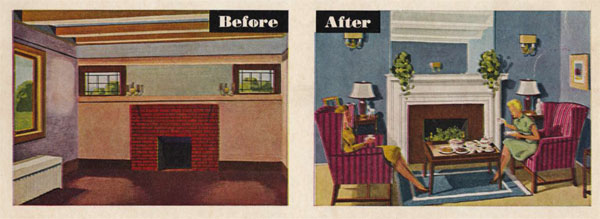Small Home Gazette, Summer 2012
Letter From the Editor: bungalow details lost to whims of homeowners
Kristi Johnson, founder of the Twin Cities Bungalow Club, recalls a bungalow owner who wanted to replace all of his kitchen’s original birch cabinetry because the base cabinets didn’t have a toe-kick space. He was fixated on having that feature, she recalls. All new cabinetry has toe-kick space, he reasoned. You can’t even get new cabinets without it. Despite Kristi’s protests, he tore out the original cabinets and put in new ones. Then he sold the house.
Years ago a man told me about a beautiful bungalow his girlfriend had just bought near the lakes in Minneapolis. It was gorgeous, he said, mostly original. The only problem was that, when one walked in the front door, he said, “You’re assaulted by all that dark woodwork,” and he demonstrated by squinting and putting a hand up to shield his eyes. He proceeded to, in essence, ask my permission to paint the woodwork white, like the walls. “She has a contemporary art collection,” he explained, “and it needs a neutral background.”

In response, I mumbled something about it being a good idea to keep the original elements of an old house, but added that the house was hers and she could, technically, do what she wanted with it.
I felt lousy afterward and have been composing my “real” response ever since. I should have asked why, if she wanted a modern art exhibit space, did she buy a bungalow? I should have said that old houses have an integrity, not just exterior integrity, but one that extends to the interior as well. I should have said that maybe the problem wasn’t “all that dark woodwork,” but instead was all those white walls, and that painting them a warmer color would eliminate the harsh contrast and unify the room. A bungalow and a modern art museum are on opposite ends of the aesthetic spectrum, I should have pointed out, and forcing them to meet in the middle will result in something that is neither, and will leave the bungalow damaged.
These examples raise the larger question of just what, ethically speaking, we are “allowed” to do with our houses. Legally, unless you live in a designated historic neighborhood, you can do what you please to your house. Even in designated neighborhoods, restrictions apply only to home exteriors. The fact is, unless you live in a museum, you can do whatever you want to your home’s interior. And frankly, if someone were to propose legal restrictions on doing so, I suspect few but diehard purists would support them.
Still, it’s sad to see the gradual loss of historic detail as a result of the whims of homeowners who come and go with increasing frequency. The owners who came before us were faced with choices about what to keep and what to change or remove. How did they do, in your opinion?
If previous owners passed original elements of your house on to you, consider it a gift. You now have the option of doing the same, or making changes that the next owners will inherit. What will they think of your choices?
Note: A version of this commentary originally appeared in the Summer 2003 issue of this newsletter.











